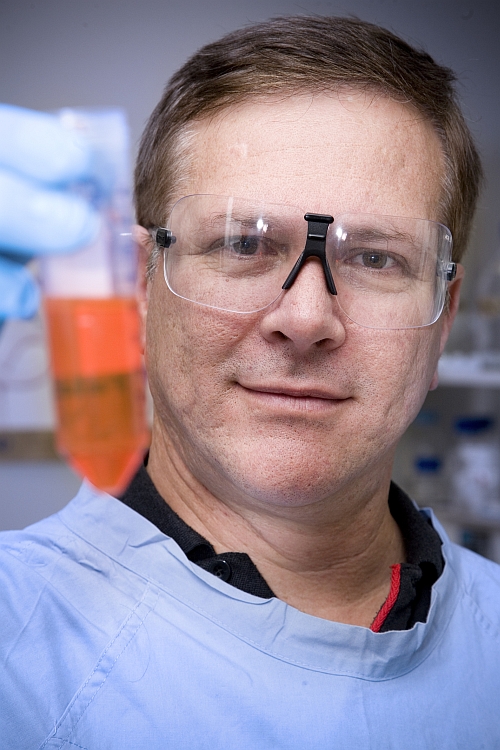Dr John Lowenthal, based at CSIRO Animal, Food and Health Science’s Australian Animal Health Laboratory, manages the Poultry CRC’s Health and Welfare program. This program is set to deliver wide-ranging benefits to the Australian poultry industry in terms of vaccine development and delivery, disease diagnostics and welfare.
According to Dr Lowenthal, one of the poultry industries’ primary concerns is disease outbreaks, as this results in both productivity loss and a reduction in bird welfare. “Disease outbreaks are easily recognisable and quantifiable, as birds present with clinical signs that prompt immediate and decisive action” he said. “Having said that, there are many subclinical or chronic diseases where the main effect is loss of productivity. Therefore, the development of new vaccines, novel delivery methods and rapid diagnostic tools will be key, moving forward. The welfare side of this equation is harder to measure, and we need to deliver industry more reliable and robust measures of bird welfare, that assess it in an objective manner.”
Below is the list of projects in Program 1 and the related outputs under the Poultry CRC’s Commonwealth Government agreement. Projects areas have been prioritised and designed, in conjunction with industry, stakeholders and research providers, to meet our agreed outputs. It is easy to understand the need for research and the value of new innovations that can be deployed to the development of now vaccines, delivery methodology and diagnostic tools. As science and technology progress, great advances can be made in the identification and treatment of avian diseases.
Developing methodology to assess bird welfare is more difficult, as these measures tend to be emotionally charged issues whereby individual personal values and beliefs may conflict with empirical evidence. Indeed, how best to gauge birds’ welfare state can itself be a highly contentious issue. CRC research is aimed squarely at eliminating subjective judgement, instead relying on evidence-based research to produce workable models and best practice when it comes to measures of bird welfare and assessments of ways of improving it. Public confidence in the poultry production system continues to be a key issue for the industry.
Dr Lowenthal points out that our poultry industry offers a more efficient system of protein production for human consumption compared to others. “The overall efficiency of the poultry production system, be it eggs or meat, our low carbon footprint and (largely) vertically integrated process means that we can provide a sustainable, safe and ethical food source into the future. New challenges are sure to arise, but with research outputs from the CRC, industry can be confident in a very bright future.”
The Health and Welfare program consists of the following projects:
- Towards commercialisation of a next-generation ILTV vaccine & differential ELISA
- Vaccine against Clostridium perfringens to protect birds from necrotic enteritis
- Vaccine strategies and interactions of attenuated coccidial vaccines
- Testing a novel adjuvant to improve immune responses to Salmonella vaccination
- Long term protection against Salmonella typhimurium
- Development of a temperature sensitive Mycoplasma gallisepticum vaccine for use in Turkeys
- Rapid multiplex PCR assay for differentiating Pasteurella multocida serovars
- Evaluation of high resolution melt curve analysis for detection of multiple strains in a single specimen (completed)
- Characterising population structure and diversity of Australian Eimeria
- Riemerella anatipestifer diagnostics
- Control of sex determination in poultry
- Application of herpes viral vectors for in ovo delivery
- New approaches to assess welfare in free range laying hens
- Development and extension of industry best practice for on-farm euthanasia of spent hens
- A new test for the measure of poultry welfare
The above projects were designed at the commencement of the second round Poultry CRC in close consultation with industry stakeholders. They are intrinsically tied to our agreed outputs with the Commonwealth Government of Australia as follows:
- Output 1.1: Vaccines for control of significant diseases are developed and commercialised
- Output 1.2: Tests available to industry through a range of diagnostic services
- Output 1.3: Methods for sex determination in poultry via in ovo delivery of RNAi molecules
- Output 1.4: New vaccine vectors, immuno-enhancers and vaccine adjuvants for in ovo delivery
- Output 1.5: New anti-viral and anti-parasitic therapeutics and anti-inflammatory agents
- Output 1.6: New evidence-based welfare methods developed
Education outcomes:
- Output 1.7: At least six Honours students, 15 postgraduates (PhDs or Masters) and three internships completed
- Output 1.8: At least 50 scientific publications and eight patent applications lodged
- Output 1.9: At least 20 graduates trained via an online program in avian disease diagnosis
- Output 1.10: Teachers’ resources in poultry health and disease and poultry welfare


